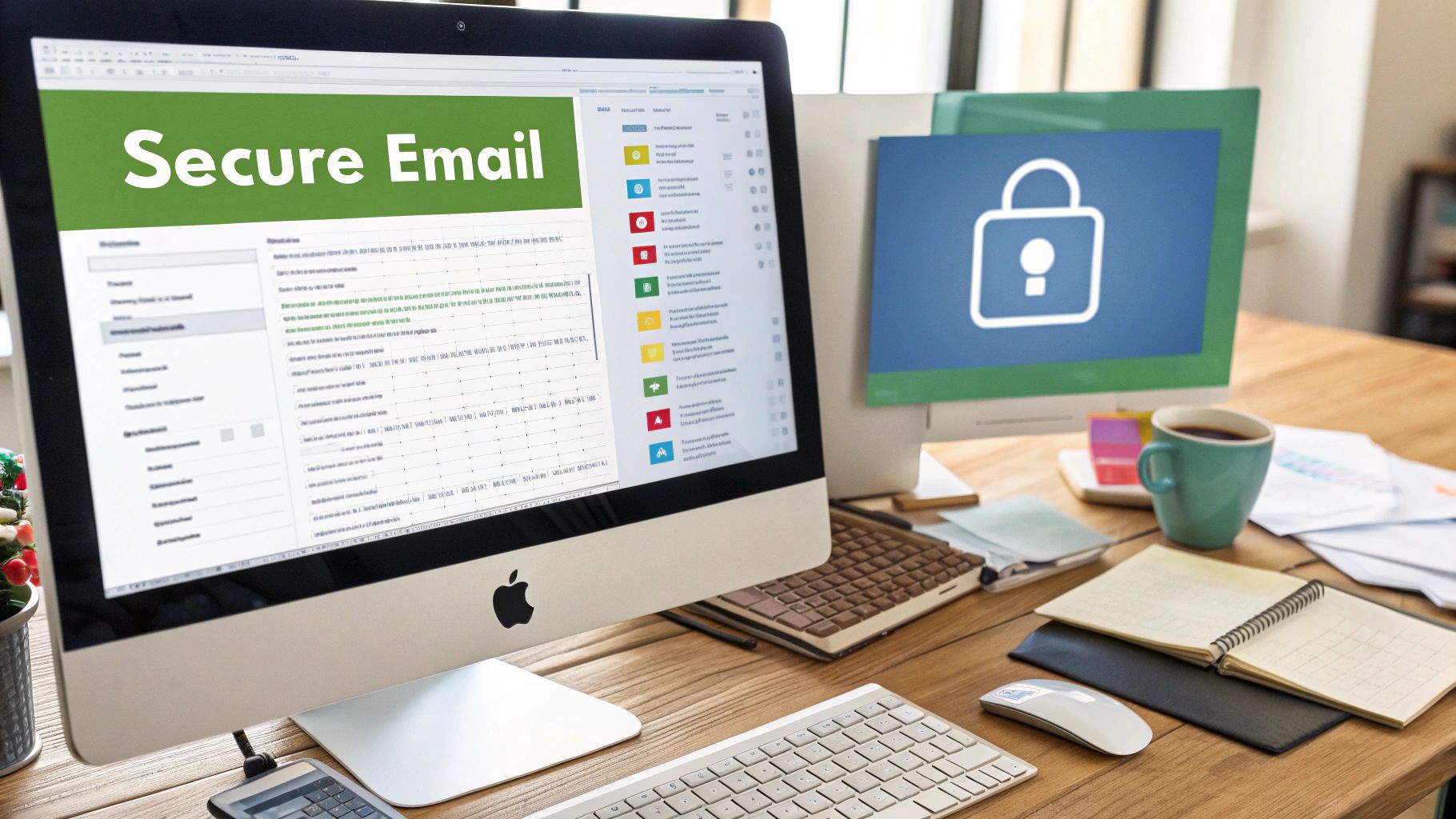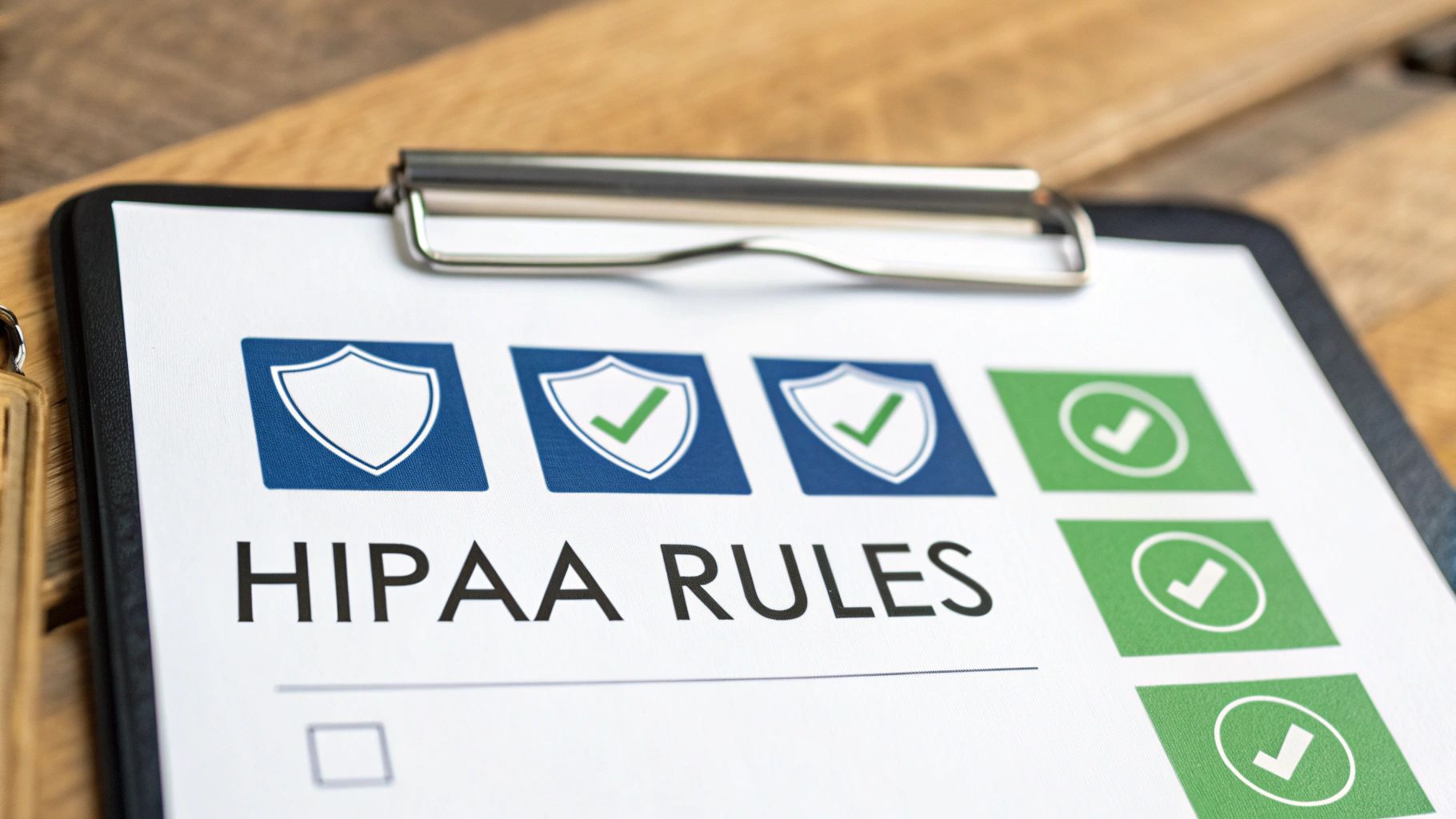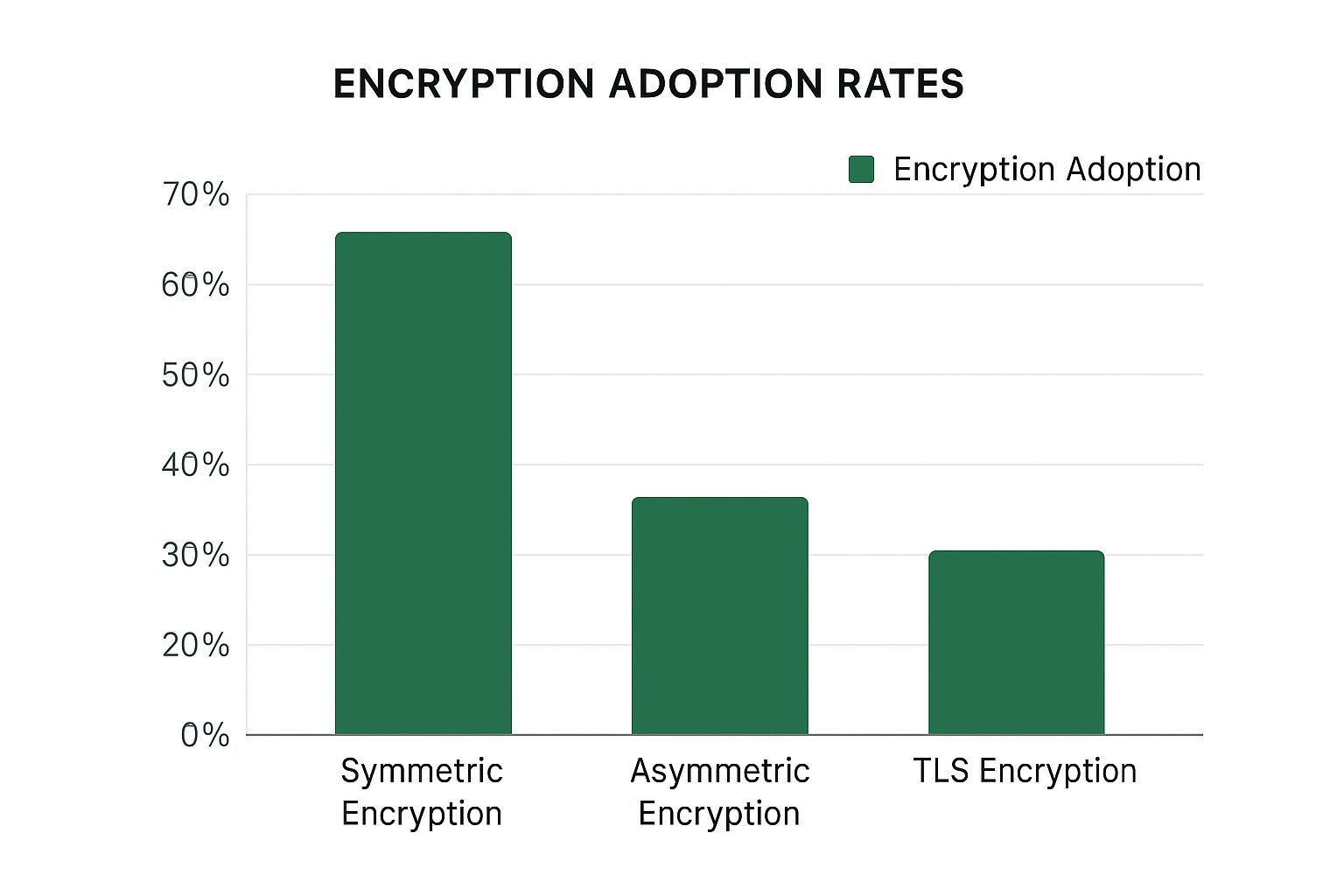Hipaa Compliant Email Encryption: Essential Guide

Understanding HIPAA Email Requirements Without the Confusion

Let's clarify HIPAA compliant email encryption. The Health Insurance Portability and Accountability Act (HIPAA) sets standards for protecting electronic Protected Health Information (ePHI). This includes email containing patient identifiers. Understanding these requirements is a legal obligation for covered entities and their business associates, impacting how your organization handles sensitive patient data. For more information on HIPAA email compliance, see this helpful resource: Learn more about HIPAA compliance for email. For broader business insights, this article may be of interest: How to master business strategies.
Encryption In Transit vs. At Rest: A Crucial Distinction
Understanding the difference between encryption in transit and encryption at rest is fundamental. Encryption in transit protects ePHI as it travels across the internet. Think of it like sealing a letter in an envelope before mailing it. This prevents unauthorized access during transmission.
Encryption at rest, on the other hand, protects ePHI stored on servers and devices. It's similar to locking a file cabinet containing sensitive documents. This safeguards information even if a system is breached. Both are crucial for HIPAA compliance.
Debunking Myths and Focusing on Real Protections
Many misconceptions exist around HIPAA compliant email encryption. One myth is that using a disclaimer is enough. This is false. HIPAA requires robust technical safeguards, like encryption.
Another myth is that all internal healthcare email must be encrypted. While encrypting all emails simplifies compliance and mitigates accidental breaches, it isn't strictly mandatory for messages without ePHI. However, encryption by default is best practice. This means encrypting every email to ensure consistent patient information protection.
Practical Implications for Your Organization
Implementing HIPAA compliant email encryption has broad implications. It requires choosing suitable email encryption solutions that balance security and usability. Staff training is vital to ensure proper procedures are followed.
Establishing clear email communication policies is also essential. These should outline what information can be emailed, how to handle sensitive data, and breach protocols. This protects patient information and helps avoid penalties.
Real Costs of Non-Compliance: Beyond the Obvious Penalties

The consequences of inadequate email protection go far beyond the immediate financial penalties for HIPAA violations. While these fines can be substantial, the long-term repercussions often have a more significant impact on healthcare organizations. A single email oversight can trigger a cascade of negative consequences.
The Ripple Effect of a HIPAA Email Breach
When a HIPAA email breach occurs, the Office for Civil Rights (OCR) initiates a thorough investigation. This process, from the initial complaint to the final resolution, can significantly disrupt daily operations, diverting valuable resources away from patient care. Furthermore, these investigations often uncover systemic vulnerabilities, necessitating costly remediation efforts.
Even a seemingly minor incident, like an employee accidentally emailing protected health information (ePHI) to the wrong recipient, can trigger a full-scale OCR audit. Such an audit might reveal broader deficiencies in the organization's overall security posture, leading to additional penalties and mandated corrective actions.
Beyond the Dollar Amount: The Intangible Costs
Beyond the direct financial costs, HIPAA email breaches erode patient trust. This loss of trust can have lasting effects on patient retention and damage the organization's reputation. To maintain compliance and safeguard sensitive data, understanding and implementing robust data privacy best practices is essential. In an era where online reviews and social media can amplify negative experiences, reputational damage can persist for years, impacting the ability to attract new patients and retain existing ones.
Moreover, the operational disruption caused by a breach often leads to decreased productivity and an increased administrative burden. Staff may be forced to spend valuable time addressing the fallout from the breach, taking time away from crucial patient care. This can further strain resources and negatively impact the quality of care provided.
The True ROI of HIPAA Compliant Email Encryption
A key driver of growth in the email encryption market is the increasing demand for security solutions that meet stringent regulatory standards like HIPAA. In the U.S., the email encryption market is projected to reach USD 1,126.3 million by 2025, growing at a CAGR of 16.60% until 2033. Factors such as the rise in cyberattacks and the need for secure communication across various industries, especially healthcare, fuel this growth. More detailed statistics can be found here. Investing in robust HIPAA compliant email encryption is not merely a cost of doing business; it's an investment in protecting your organization's reputation, patient trust, and long-term viability. Proactive security measures can save organizations significant money and resources compared to the multifaceted costs associated with security failures. By prioritizing HIPAA compliant email encryption, healthcare organizations can transform a potential vulnerability into a competitive advantage.
Essential Features That Make Email Truly HIPAA Compliant
HIPAA compliant email encryption is crucial for healthcare organizations. It's not just a box to check, but a vital safeguard for protecting sensitive patient data. But what makes an email system truly HIPAA compliant? This section explores the essential features that separate robust solutions from those merely claiming compliance.
Encryption Methods: Ensuring Confidentiality
At the heart of HIPAA compliant email is the encryption method. Different approaches exist, each with its own pros and cons.
- End-to-End Encryption: This method encrypts messages at the sender's end, decrypting only at the recipient's end for maximum security. However, this can sometimes present usability challenges.
- TLS Encryption (Transport Layer Security): TLS encrypts email in transit between servers. While widely used, it doesn't protect messages stored on a server.
- S/MIME (Secure/Multipurpose Internet Mail Extensions): S/MIME offers strong encryption, but its requirement of digital certificates can be complex to manage.
To help illustrate the various encryption methods and their adoption rates, let's look at the following table:
Comparison of HIPAA Compliant Email Encryption Methods
| Encryption Method | Security Level | Ease of Implementation | User Experience | Cost Considerations | Best For |
|---|---|---|---|---|---|
| End-to-End Encryption | Highest | Moderate | Can be complex | Moderate to High | Organizations with strict security needs |
| TLS Encryption | Moderate | Easy | Seamless | Low | General communication with moderate security needs |
| S/MIME | High | Difficult | Can be complex | Moderate to High | Organizations requiring high security and authentication |
This table summarizes the key differences between the most popular HIPAA compliant email encryption methods, allowing organizations to choose the best fit for their needs. Choosing the correct encryption method balances security needs with practical implementation and user experience.

Access Controls: Limiting Who Sees What
Strong access controls are essential for HIPAA compliance. They determine who can access, modify, or delete protected health information (PHI).
- Two-Factor Authentication: This adds an extra security layer, requiring two different verification methods.
- Role-Based Access Control: Access is granted based on a user's role, ensuring appropriate access levels.
- Audit Trails: Logs of all email activity track access and identify potential breaches.
These measures restrict PHI access to authorized personnel, minimizing breach risks.
Business Associate Agreements (BAAs): Shared Responsibility
HIPAA requires covered entities to have Business Associate Agreements (BAAs) with third-party vendors handling PHI. These agreements legally obligate the vendor to uphold HIPAA standards. A BAA clarifies each party’s responsibilities for protecting patient data.
User Experience and Integration: Balancing Security and Workflow
Security is paramount, but HIPAA compliant email must also be user-friendly and integrate smoothly with existing workflows. Cumbersome systems can hinder adoption and compromise security through workarounds.
Features like automatic encryption and intuitive interfaces simplify compliance without impacting clinical efficiency. Integration with existing email clients like Google Workspace or Microsoft 365 streamlines workflows.
Ongoing Monitoring and Auditing: Maintaining Compliance Over Time
HIPAA compliance isn't a one-time fix. Ongoing monitoring and auditing are crucial for maintaining effective security. Regular risk assessments identify vulnerabilities, and strong incident response plans address potential breaches quickly. Staying current with security practices ensures long-term compliance and maintains patient trust.
Implementing Encrypted Email: A Practical Roadmap to Success

Successfully implementing HIPAA compliant email encryption requires a structured approach. It's not simply about choosing the right software. It's about seamlessly integrating that software into your existing workflows. This section provides a practical roadmap, outlining the key steps for successful implementation.
Phase 1: Assessment and Planning
A thorough assessment is crucial before exploring solutions. This involves identifying potential risks and vulnerabilities associated with your email communication.
- Identify ePHI Flow: Map how electronic protected health information (ePHI) moves within your organization, both internally and externally.
- Risk Assessment: Analyze potential threats and vulnerabilities. Consider factors like human error and malicious attacks.
- Resource Inventory: Evaluate your existing IT infrastructure and available resources.
This initial phase creates a solid foundation for successful implementation.
Phase 2: Solution Selection and Implementation
Choosing the right HIPAA compliant email encryption solution requires careful consideration. For organizations that need to transcribe audio data, using a service that understands healthcare privacy is key. Consider solutions offering HIPAA compliant transcription. The solution you choose should align with your organization's specific needs and resources.
- Vendor Evaluation: Compare different vendors, focusing on features, security certifications, and cost.
- Pilot Program: Test the chosen solution with a small group before a full-scale deployment.
- Technical Integration: Integrate the solution with existing email systems and workflows. Smooth integration minimizes disruptions and encourages user adoption.
Careful selection and methodical implementation help prevent future complications.
Phase 3: Staff Training and Policy Development
Technology alone isn't enough for long-term compliance. Staff training and clear policies are essential.
- Training Program: Develop a comprehensive training program. Cover both technical aspects and email best practices.
- Policy Development: Create clear and concise email usage policies. Outline what can and cannot be emailed, how to handle sensitive information, and incident response procedures.
- Ongoing Support: Provide ongoing support to address staff questions and reinforce best practices. This ensures continued adherence to established policies and procedures.
These steps empower staff to use the encrypted email system effectively and securely.
Phase 4: Ongoing Monitoring and Maintenance
HIPAA compliance is an ongoing process, not a one-time event. Regular monitoring and maintenance are essential.
- Performance Monitoring: Track key metrics like email delivery rates and security incidents.
- Regular Audits: Conduct periodic audits to ensure continued compliance with HIPAA regulations and identify areas for improvement.
- Incident Response: Establish clear procedures for handling security incidents. Swift and effective responses minimize damage and help prevent future incidents.
This proactive approach keeps your email encryption strategy effective and up-to-date. It also reinforces the importance of compliance among your staff. The global email encryption market is expanding rapidly, reflecting the growing need for secure communication. The market is expected to grow from USD 7.75 billion in 2024 to USD 40.16 billion by 2033. This demonstrates the increasing prioritization of data protection across industries. You can find more detailed statistics here. By implementing a robust and well-maintained encrypted email system, healthcare organizations not only protect patient data but also ensure the long-term security and success of their operations.
Managing HIPAA Compliant Communication That Works
Implementing HIPAA compliant email encryption isn't simply about the technology itself. It's about building a culture of security within your organization. This involves creating practical email management strategies that fit smoothly into the everyday routines of a healthcare setting. Finding the right balance between strict security and efficient clinical workflows is the key to successful implementation.
Building Email Policies for Real-World Healthcare
Effective email policies need to function within the fast-paced, high-pressure realities of healthcare environments. Based on conversations with compliance experts, we've identified some core best practices. For instance, policies should clearly define what information qualifies as Protected Health Information (PHI) and how it should be managed in emails. They should also provide guidance for specific situations, such as emergency communications and consultations, outlining the appropriate encryption and communication methods. This approach helps ensure compliance while maintaining the flexibility necessary in dynamic healthcare settings.
Content Management: A Tiered Approach
Different communication scenarios call for different content management strategies. Internal consultations, for example, might allow for slightly less formal language, assuming proper encryption is used. However, communications with patients require more formal language and strict adherence to PHI guidelines. External partnerships pose their own set of challenges, requiring a solid understanding of the partner’s own security protocols and compliance standards. Adapting your content management strategies to these various scenarios ensures efficient communication while minimizing potential risks.
Navigating Complex Situations
HIPAA compliant communication can be particularly tricky in complex or unusual circumstances. During emergencies, for example, speed is of the essence, but security can't be sacrificed. Similarly, staff transitions require careful oversight of access credentials to prevent unauthorized access to PHI. And patient communication when technical limitations exist, such as limited internet access, might require alternative secure methods. Establishing clear protocols for these types of situations is essential for maintaining HIPAA compliance.
Real-World Examples of HIPAA Compliant Communication
Many healthcare organizations have successfully integrated HIPAA compliant email into their daily operations. One example involves a large hospital system that implemented a tiered encryption system. Internal communications used standard TLS encryption, while external communications with patients and partners used end-to-end encryption with automatic key management. This streamlined the process while enhancing security. Another example is a small clinic that adopted a secure messaging platform for fast, compliant communication between staff and patients. This reduced their reliance on traditional email for routine communication, significantly lowering risk.
Email Content Risk Assessment
To help healthcare staff make informed decisions about what types of PHI can be safely included in encrypted emails, the following table provides a framework for assessing risk in different scenarios:
Email Content Risk Assessment Framework
| Information Type | Risk Level | Encryption Requirements | Additional Safeguards Needed | Recommended Approach |
|---|---|---|---|---|
| Patient Names, Addresses, etc. | High | Required | Two-Factor Authentication | Encrypt all emails containing this information |
| Internal Scheduling Information without Patient Identifiers | Low | Recommended | None | Standard email practices acceptable, encryption preferred |
| Medical Images | High | Required | Secure File Transfer Protocol | Use specialized secure file transfer systems for sensitive data |
This table highlights the importance of a multi-layered approach to HIPAA compliant email encryption. By combining robust encryption with strong access controls and well-defined content management guidelines, healthcare organizations can achieve both secure and efficient communication. Choosing a secure email hosting platform like Typewire can significantly assist in meeting these requirements. Their focus on privacy and security by design aligns perfectly with HIPAA requirements for protecting ePHI. By proactively addressing security, healthcare providers can build patient trust and maintain compliance in a constantly changing environment.
Future-Proofing Your HIPAA Compliant Email Strategy
The healthcare industry faces constant change, and so do the risks to patient data. This means your organization's approach to HIPAA compliant email encryption must be adaptable and forward-thinking. Are you ready for what's next? This section explores emerging technologies and strategies shaping secure healthcare communications.
AI-Powered Threat Detection: The Next Level of Security
Artificial intelligence (AI) is rapidly changing cybersecurity. AI-powered systems can analyze enormous amounts of data to detect and respond to threats in real time, exceeding human capabilities. These systems can identify unusual email patterns, flag phishing attempts, and even predict potential vulnerabilities. This proactive security approach offers a significant advantage in protecting against increasingly complex cyberattacks. For more information about AI, visit the Microsoft Azure AI Fundamentals page. You might also be interested in learning more about Typewire.
Zero-Trust Security: Assume Nothing, Verify Everything
The zero-trust security model operates on the principle of "never trust, always verify." Every user, device, and application accessing protected health information (PHI) must be authenticated, regardless of location or network. This eliminates the vulnerabilities of traditional perimeter-based security, which assumes internal network users are trustworthy. By continuously verifying access, zero-trust security adds extra protection, making unauthorized access to sensitive data far more difficult.
Secure Messaging Alternatives: Beyond Traditional Email
While email remains a primary communication tool, secure messaging platforms designed for healthcare are gaining popularity. These platforms often have features like end-to-end encryption, message retraction, and built-in audit trails. They offer a more secure alternative to traditional email for specific communication types, especially for sensitive patient-provider communication requiring the highest level of protection. Consider exploring options like Signal or other secure messaging platforms for healthcare.
Adapting to Evolving Patient Expectations
Patient expectations for digital communication are also influencing security strategies. Patients want convenient, secure online access to their health information. Healthcare organizations must adopt user-friendly solutions that prioritize both security and patient experience. Cumbersome portal-based systems are becoming less acceptable, while seamless, integrated encryption solutions are increasingly essential.
Building Flexibility Into Your Strategy
Future-proofing your HIPAA compliant email strategy requires flexibility. Choose solutions that can adapt to emerging threats and changing regulatory requirements. This adaptability ensures long-term compliance and organizational agility. Regularly reviewing and updating your security policies and procedures maintains their effectiveness. Investing in a secure email hosting platform like Typewire can be helpful in achieving these goals. Its focus on privacy and security by design aligns with HIPAA requirements for protecting ePHI. Typewire provides a robust and user-friendly platform for managing sensitive communications, helping you stay ahead of evolving threats and maintain HIPAA compliance.
Hipaa Compliant Email Encryption: Essential Guide
Posted: 2025-05-20
Choosing an Encrypted Email Solution for Your Business
Posted: 2025-12-14
What is email deliverability: Your guide to inbox success
Posted: 2025-12-13
What Is SMTP Authentication? A Guide to Email Security and Privacy
Posted: 2025-12-12
How to Create Email Templates Securely and Effectively
Posted: 2025-12-11
Unlock Inbox Peace: How Can I Stop Receiving Spam Emails and Reclaim Control
Posted: 2025-12-10
Discover how to send encrypted emails: A practical guide to secure messaging
Posted: 2025-12-09
How to Host an Email Server: A Guide to Privacy and Security
Posted: 2025-12-08
10 Secure Email Communication Best Practices for 2025
Posted: 2025-12-07